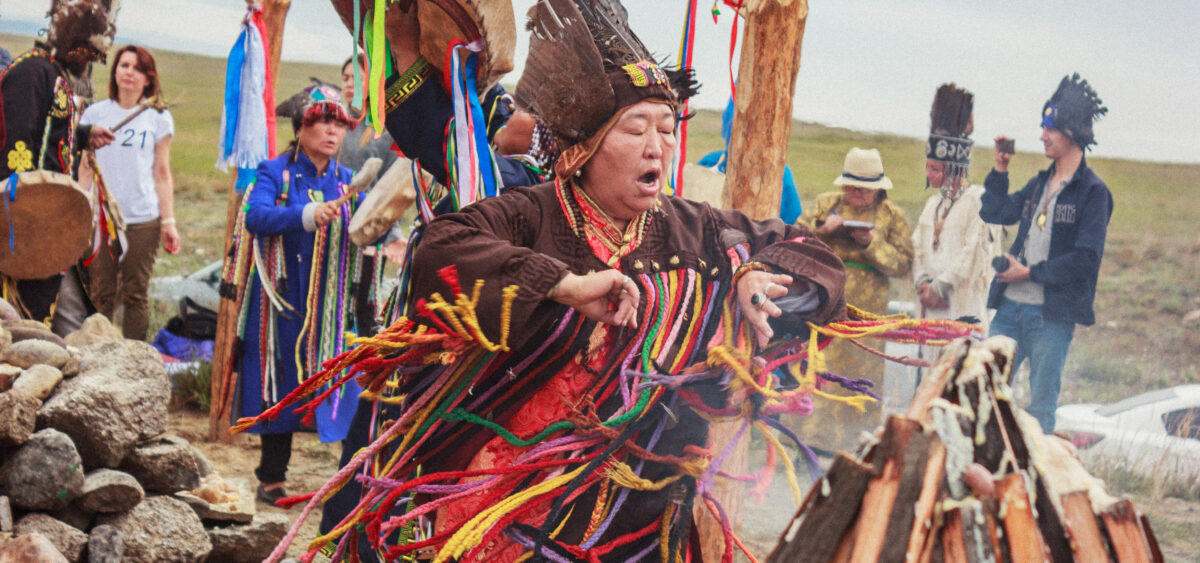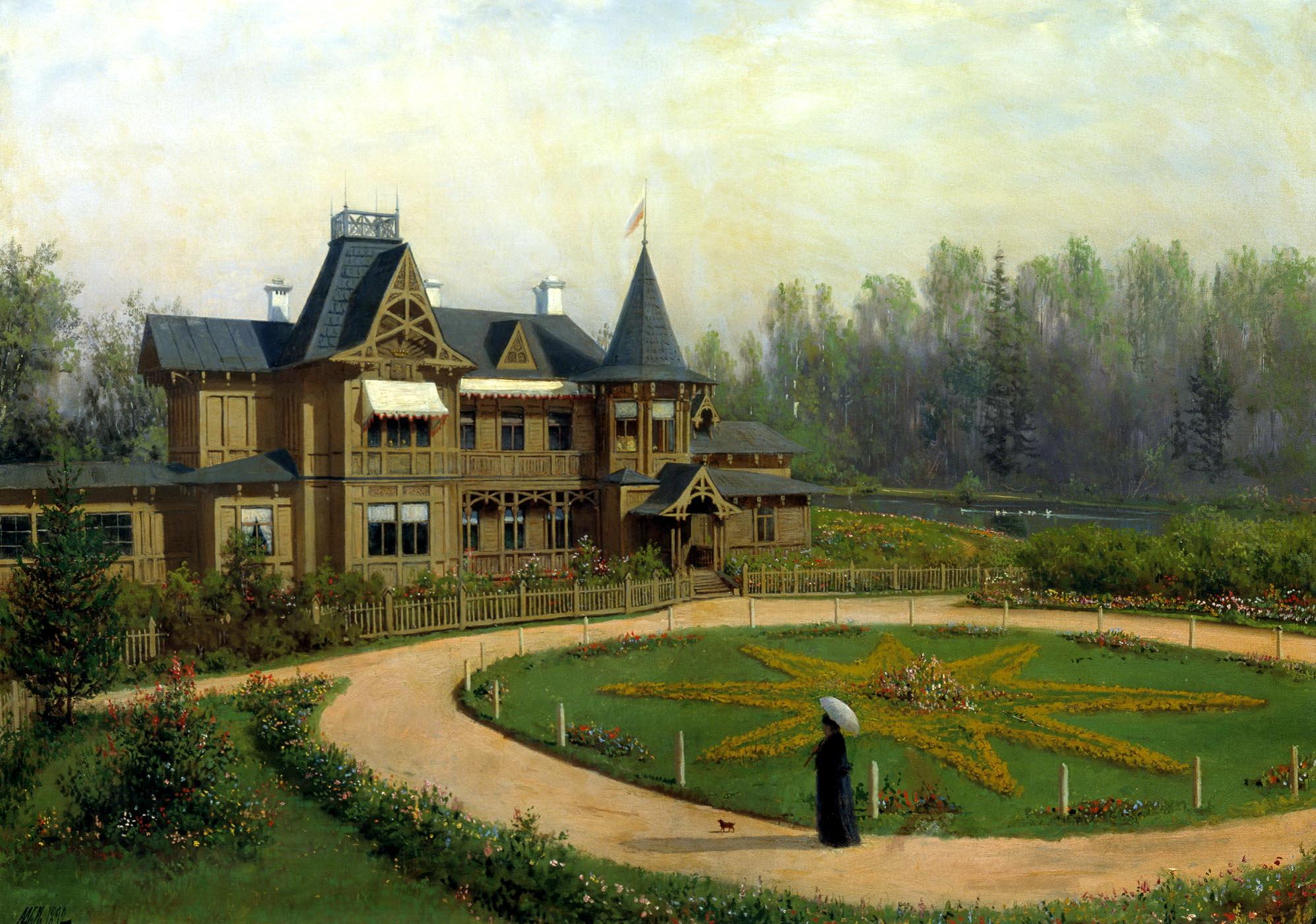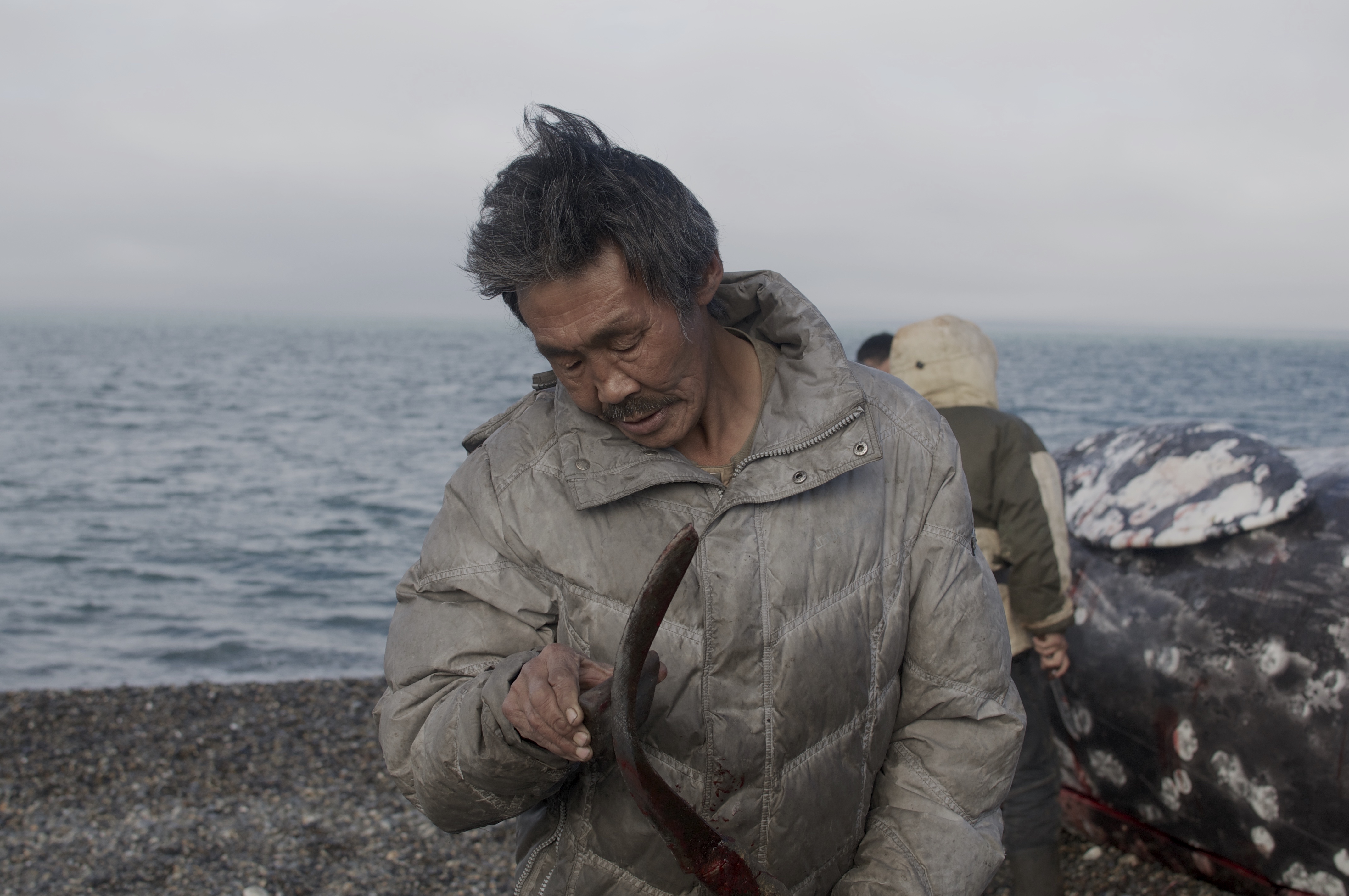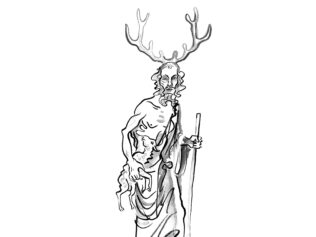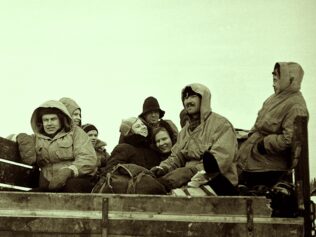
Siberian spirituality, illegal under the USSR and gradually recovering since that system collapsed, is still viewed askance by those at the top in Russia. The situation isn’t made any easier by internal disputes: while the spirits tell some shamans to move with the spirit of the age, others are told to go to Moscow.
In the late summer of 2021, the Third All-Russian Congress of Shamans was held in Kyzyl. Dozens of delegates from all over Siberia gathered in the capital of the autonomous Tuvan Republic. For several years, representatives of shamanist organizations had petitioned the central authorities in Moscow to formally recognize shamanism as one of Russia’s ‘traditional religions’. So they were racking their brains to find something more they could do for the leaders of Russian shamanism to be welcomed into the Kremlin with full honours, alongside the Orthodox Patriarch of Moscow and all Rus’, the chief muftis, the chief rabbi of Russia, and Buddhism’s Pandito Khambo Lama.
The Shamans’ Congress took place in quite a nervous atmosphere. In recent years, much has been done to unite Russia’s shamanist organizations, but they still haven’t managed to create a single unitary structure representing the interests of all regions. What’s worse, the echoes haven’t died down of a certain well-publicized scandal, which for two years has drawn attention not only in Russia, but also far beyond its borders.
At the plenary session, a local Tuvan shaman, Kara-Ool Tiuliushevich Dongun-Ool, holder of the title of Supreme Shaman of Russia, took the floor. In an irritated tone, the veteran activist started to attack the impudence of the Church and the way it places crosses wherever it likes – even in shamanist holy sites. The Russian Buddhist sangha was also a target, for building monasteries in majority-shamanist areas. Finally, Tiuliushevich got to the hottest topic, declaring (as quoted by the RIA Novosti news agency): “Dear colleagues, as you know well, a psychologically unbalanced homeless Yakutian has declared himself a shaman and started walking to Moscow. In countless media reports there hasn’t been a word about how this man isn’t a true shaman, just an ordinary usurper! The arrival on the scene of more opposition pseudoshamans is just a question of time. Meanwhile, the authorities don’t want to see the difference between these Gabyshevs and the representatives of traditional shaman organizations. The results may be tragic, as the authorities will soon see.”
The shaman goes to Moscow
Over the past two or thee years, Aleksandr Gabyshev has become perhaps the most recognizable representative of the Indigenous nations of Siberia. He was born in the mid-1960s. Gabyshev says he studied geology for a year. Then he ended up in the army, and after returning to civilian life he completed history studies at a university in Yakutsk. Influenced by his wife, he was baptised in the Orthodox rite. After she died, he experienced a breakdown and fell into depression. When he recovered, he left the city, became a vegan and lived alone in a hut in the forest. There, the guardian spirits were to reveal themselves to him.
After returning to Yakutsk, Gabyshev took up various activities, working as a welder and a janitor, among other professions. Around 2009, another breakthrough moment supposedly took place in his life: he once again heard the call of the spirits. As he says, despite his baptism, the ancient faith of his ancestors was always very important to him. But earlier he had tried to combine shamanistic ideas with Christianity. Now he had become someone completely different: a warrior shaman.
As I learned from friends in Yakutsk, until 2019 Gabyshev wasn’t a completely anonymous figure. He was a bit of niche local colour. He’d show up in various places, sometimes presenting himself as a hermit sage, sometimes as a trainer of traditional wrestling. From time to time, a few city dwellers seeking unique spiritual experiences would gather around him. But most often he operated alone, without drawing any particular attention.
All that changed in March 2019. That’s when Gabyshev announced he was starting his walk to Moscow, to drive out “the evil spirit that has taken up residence in Vladimir Putin”. Initially, he was treated as a curiosity. But late in the spring, Gabyshev arrived, across the taiga and the wilderness, in southern Siberia. The first big city he reached was Chita. In the capital of Zabaykalsky Krai, he appeared at an opposition protest. Speaking from a small stage, Gabyshev promised to expel the evil spirits from the Kremlin, declaring that Russia’s highest authority should be handed over to the people.
By the time he left Chita, he was a media icon of the people’s rebellion against injustice and the excesses of the Kremlin camarilla. Top news services reported on where he was, what he said, what he ate, how he slept and rested. Surrounded by a small group of followers, Gabyshev marched toward Ulan-Ude in Buryatia. In that republic, his path was blocked by members of the Tengeri shamanist organization. The self-described shaman-patriots called on him to turn around and told him they didn’t consider him a true shaman. Bair Tsyrendorzhiyev, the leader of Tengeri, one of the aspiring leaders of Russian shamans, publicly called him a charlatan.
Despite all this, Gabyshev didn’t give up, continuing his march to the West. But not far from Irkutsk, on the Baikal federal highway, he was detained by a special unit of the OMON police and transported to Yakutsk. That’s how our shaman first arrived at a psychiatric clinic, and the local prosecutor opened a case against him on suspicion of provoking political extremism. His problems with the prosecutors – and two months in a psychiatric ward – didn’t teach him anything.
After leaving the hospital, Gabyshev announced another march on Moscow. This time he was detained a lot sooner. During the arrest, he attempted to defend himself. He was beaten up, and declared insane. After which he once again ended up in a psychiatric ward. Finally, in February 2021 a court in Yakutsk sent him to indefinite psychiatric treatment in a closed ward.
Behavioural norms derive from the specifics of cultures. A condition which from the point of view of Western psychiatry we can consider an illness won’t necessarily be treated that way in a different cultural order. It’s hard to state objectively whether Gabyshev is a shaman or not. Also significant is the content of the visions that a future shaman experiences, particularly whether they include the theme of a journey among three worlds: the heavenly; the intermediate (earthly); and the afterlife, most often underground. Shamans usually come from families in which for two or three generations back, people were born who have been ‘called by the spirits’.
According to tradition, such people should go through initiation rites, led by experienced, authoritative shamans. In practice, they decide which of their adepts truly had a view into other, not universally-accessible dimensions of reality and is able to communicate with them, and who’s a mountebank or an unbalanced weirdo. But there have not been formalized procedures or institutions that have a complete monopoly on deciding who can be a shaman and who can’t.
In any case, the treatment of Gabyshev drew numerous comments on the state of consciousness of Putin and his entourage. Much attention was devoted at the time to the mixture, popular in Moscow circles, of Eastern philosophy, astrology, numerology, yoga, faith in natural and cosmic energy, the magic of shamans and extrasensory perception. Rumours and theories on the esoteric fixations of the Russian elites is a whole separate topic. Certainly much of it is humbug made up out of whole cloth, but the merciless pacification of Gabyshev really did set off a discussion. In the media, there was no shortage of sarcastic comments that the almighty Putin was scared of the supernatural power of a lone man walking toward him from the depths of darkest Siberia.
The incarnation of the leader
At the summits of power, Defence Minister Sergey Shoygu is considered a discreet acolyte of shamanistic practices. Putin’s trusted factotum, often mentioned as a potential successor, he was born in the small Tuvan town of Chadan, in a region known for its syncretistic shaman-Buddhistic traditions. His father, Kuzhuget Seree oglu (son of Sergey), worked for most of his life as a provincial journalist and local party apparatchik. But it’s said that he was also a shaman. In the USSR, shamanism was practised in secret. Shamans were persecuted, convicted of medical fraud, locked in psychiatric hospitals, often with a diagnosis of schizophrenia. The defence minister doesn’t comment on reports on his father.
In his home region of Tuva, Shoygu is a particularly popular figure. Portraits of him can be seen on apartment blocks and murals. Recently the inhabitants of Tuva declared him the incarnation of Subutai, one of the most effective military leaders of the Mongol Empire. Subutai’s exploits included a victory in the Battle of the Kalka River, which began the collapse of the Kyivan state. The famous leader – similarly to the current defence minister of the Russian Federation – was born in Siberia, on the banks of the upper Yenisey, more or less in the Tuva Depression. But right now we’re not going to concentrate on fantastical stories about the supernatural powers of Sergey Shoygu, which he apparently possessed in previous lives. Let’s just assume that recognizing him as the incarnation of the warlike Subutai is a traditional regional way of showing respect for an outstanding countryman.
The famous son of the holy Tuvan land hasn’t forgotten his roots. Rumours of his shaman father, holy mountains and monumental landscapes of the Western Sayan have become an element of his media image. For several years he has regularly invited Putin to Tuva, and in his train, photographers and TV crews. In a recurring media spectacle, Russian viewers can see two strong men tackling steep mountain trails, fishing in crystal-clear rivers, lying down to sleep in the light of a fire and rising at the crack of dawn. There’s also room for the metaphysics of the elemental forces of nature, brought up by the authors of propagandistic reports from Putin’s survivalist escapades with his trusty companion Shoygu.
At the same time, Shoygu ostentatiously manifests his attachment to Orthodoxy. Since he was named defence minister, a regular element of the Victory Day celebrations is a bow to the Image of the Saviour Not Made by Hands at the Kremlin’s Spasskaya Tower. Shoygu, who years ago managed to evade military service, has the custom before the victory parade of bidding farewell under the holy picture, after earlier removing his cap. And not just any cap; it’s nearly identical to the one on the monument of Georgy Zhukov not far from Red Square.
The minister also wears his Soviet marshal’s getup during frequent visits to churches. It was thanks to his efforts that a gargantuan, khaki-coloured cathedral for the armed forces was erected in Patriot Park near Moscow. When it was ceremonially opened in 2020, many theologians shook their heads, stating that they associated the building more with a postmodern shrine to a warrior cult than a Christian temple.
I don’t know how seriously Shoygu treats Tuvan tradition, Orthodoxy or Buddhism. Nor do I know whether anybody in Moscow was seriously frightened by Gabyshev. But the bumptious statements of the self-declared scourge of the Kremlin’s spirits, the public interest he aroused, and the ostentation with which he showed he wasn’t afraid of anybody must have seriously disturbed the regional elites in Siberia. After all, somebody in the capital could have drawn the conclusion that the controversy around Gabyshev attests to the local authorities loss of control over the situation. That’s precisely why he was detained on the road from Ulan Ude to Irkutsk by a special pursuit group sent from Yakutsk.
Even greater fear must have gripped the Siberian shamanism activists. The organizations they represented had lobbied by the sweat of their brows for the recognition of shamanism as one of Russia’s ‘traditional religions’. That status means the ability to receive federal funds, long-term subsidies and the inclusion of representatives of shamanism in bureaucratic structures, such as the Social Chamber, which divvies up state grants. Just as something was finally happening, regional and ethnic divisions were being broken down, a relatively coherent structure of a central shamanist organization was being put together, a divine madman from Yakutsk bursts onto the scene – and he declares that the spirits have ordered him to march to Moscow.
Carrot and stick
The relationship between spirituality and the social and political order is as old as time. The current shape of relationships between the state and the Russian confessions reaches back at least as far as the reign of Catherine the Great. Orthodoxy became the dominant, privileged religion of the Russian Empire, but in the second half of the 18th century Catherine introduced a tolerant model of relations between the state and other confessions. Still, we would be naive if we wanted to see in this merely Catherine’s desire to be recognized in history as the first truly enlightened monarch.
The more the empire expanded, the more non-Christian populations appeared within its borders. The addition of successive provinces meant that in the 18th century, dissenters became a significant challenge to the Russian administration. In the 19th century, the number of so-called inorodtsy – religiously, culturally and ethnically different people – became one of the most important internal problems for the monarchy. In 1917, when the Romanov dynasty fell, Orthodox ethnic Russians were just under half of the population of the Eurasian empire.
So granting other confessions the status of so-called tolerated religious and the related privileges was a practical step. It brought masses of non-Orthodox subjects into the state system. In this way Islam, Buddhism and Judaism became state religions of the Russian Empire. The Tsar’s court, if needed, strengthened the position of Islam and Buddhism. For example, in the 18th century the Empire supported the Buddhist confession in Transbaikal, seeking to win the loyalty of the Buryat lamas and limit the influence of the Qing dynasty in Russia’s Asian provinces. In turn, to cut off the activities of mullahs from Chiva and Bukhara in Central Asia, in the 1880s the Tsarist government financially endowed loyal Tatar clergy and sent them out onto the Kazakh steppe.
As a result of these changes, great masses of Indigenous Siberians who held traditional beliefs, which today are known by convention as shamanism, remained outside the state system. The Siberian faiths were treated by the state and the church as primitive superstition, while converting the so-called pagans to Orthodoxy became one of the imperial administration’s priorities. Evidence of the political motivations for propagating Orthodoxy include the fact that until the start of the 19th century, the organization of missionary activity was handled mainly by the state. Special commissions and offices were created for this purpose, such as the government Representation for Conversions in the southern Urals and in Central Asia.
The carrot-and-stick method was commonly used. Those who were reluctant to be baptised were repressed. The neophytes, on the other hand, were granted tax relief; their period of military service was shortened and they were bought off with goods or cash. Various social pathologies and abuse arose. The new converts often complained that even though they had accepted baptism, the local officials didn’t pay them the promised compensation, or that in violation of the agreement, they were still being plundered by high taxes. In turn, the Tsar’s officials reported on insincere conversions and lamented the locals’ cold calculation. In their reports they described fraudsters who went from place to place, being baptised over and over and collecting the payments. The priests, meanwhile, complained of the lack of interest in the Word of God among the locals, and the cultivation among the neophytes of ‘pagan rites’. It even happened that after some time, those who had been baptised chased out the priests sent by the church, and didn’t agree to accept new ones.
The Indigenous Siberians were widely dispersed, and their culture – contrary to appearances and to what the officials were able to perceive – diverse. The Russians didn’t understand their beliefs and worldviews. Often they were unable to find a single group that both was willing to cooperate and enjoyed widespread authority. The shamans were no good for this role. They didn’t create a hierarchical religious structure that could be used as an instrument of administration. An individual shaman was usually associated with a specific lineage, a relatively small territory or, in the best case, a tribal group. Their presence strengthened the clan/lineage divisions.
Shamans usually worked alone. The fact that they were considered people who had contact with other dimensions of reality often doomed them to a particular type of exclusion. They were considered useful in particular situations; they evoked respect, but simultaneously fear and unease. In everyday life, they were more on the margins of their communities.
The invisible
When the Soviet Union was sliding toward collapse, the ideological landscape of Russia was barren. One of the reactions was the so-called national rebirth in Siberia. In the 1990s, a variety of political, cultural and religious organizations began to appear, seeking to fill the empty symbolic space. So-called shamanism – a concept that in itself is up for debate, and which many researchers say is the product of a European, encyclopaedic compulsion to order and classify reality – was adopted by some of the descendants of the Indigenous Siberians as a tool serving to re-establish cultural distinctiveness.
During the reconstruction of a tradition devastated by the USSR, a reality that had never existed before was partially created. At the turn of the millennium, there appeared structured shamanist organizations. Shamanism began to be talked about as a religion (another strictly European concept). Here and there people even took to building temples. Over time the new shamanists came to want recognition at the political and institutional level.
The attempt to enter into state structures is not the only manifestation of submission to the spirit of the age. In his speech, the Khakas delegate to the Third All-Russian Congress of Shamans, a certain Aleksander Kotozhekov, devoted a great deal of attention to environmental trends. Everyone can see that humanity is thoughtlessly destroying nature, not respecting the Earth, and in fact it’s actually the shamans, Kotozhekov said, who should stand at the head of the global fight to rescue the planet from catastrophe. Ecology may offer a chance for somebody to finally treat the shamans seriously.
Many practising shamans are quite sceptical of these ideas. That which can be called national or global shamanism they treat with suspicion, as inauthentic or very opportunistic. How can you unify that which is by definition diverse? Shamans are associated with defined groups and areas. The traditions differ not only between regions – Yakutia, Buryatia, Tuva, Altay, Khakas, and many others. Each local community had its own distinct identity. The traditions of one valley differ from those of their neighbours.
It’s easy to classify the delegates to the All-Russian Congress of Shamans as opportunists whose activity is fundamentally contradictory to a centuries-old tradition. But some members of shamanist organizations don’t see any solution other than to adapt to contemporary political realities. Otherwise, they fear, they’ll never get out of the open-air museum of an ethnological attraction, and in the best case they’ll be left to play the role of ‘noble savages’, whom the world watches in order to be satisfied with the blissful pleasure of communing with simple truths proclaimed by people who have access to the depths of virgin nature.
Achieving legal status and the title of ‘traditional religion’ is not just privileges and money – though of course they’re not unattractive. The game is also being played for official recognition of a fully-valued community, marginalized and culturally deracinated for centuries. The situation in which members of shamanist organizations have found themselves is thus not particularly fun. It’s an absurd chasing of subjectivity in a world whose rules have been set by others, according to a different understanding of the world that’s been imposed.
Translated from the Polish by Nathaniel Espino


